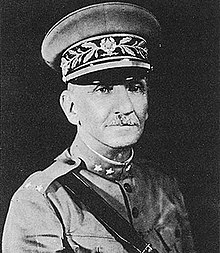Isidoro Dias Lopes

Isidoro Dias Lopes (Dom Pedrito, 30 June 1865 — Rio de Janeiro, 27 May 1949) was a Brigadier General of the Brazilian army, often styled the "Marshal of the Revolution of 1924".[1]
Early life[]
Isidoro Dias Lopes was born in the city of Dom Pedrito, Rio Grande do Sul, on 30 June 1865, son of José Tavares Bastos Rios and Jacinta Barros Lopes.[2] He joined the army in 1883 through the pt:Escola Militar de Porto Alegre, completed a course in artillery and in 1891 was promoted to lieutenant.[2] He supported the movement to bring the Empire of Brazil to an end. In 1893, he left the army and took part in the Federalist Riograndense Revolution in Rio Grande do Sul, against the government of Floriano Peixoto. After the defeat of the federalists, in 1895, he went into exile in Paris. In 1896, he benefited from an amnesty and returned to Brazil, resuming his position in the army in Rio de Janeiro.[1][3]
Revolution of 1924[]
Dias Lopes was one of the leaders of the Revolution of 1924. He had started the conspiracy against President Artur Bernardes the previous year after a reform of the military, by which time he was already a general. In 1924 he was elected leader by the conspirators and spent time organising forces in Paraná and Rio Grande do Sul. Together with pt:Joaquim do Nascimento Fernandes Távora he planned to occupy the city of São Paulo. Armed conflict broke out there on 5 July 1924, scheduled to coincide with the second anniversary of the uprising in the Forte de Copacabana.
The rebels took over the quarters of the pt:Força Pública and the 2nd Military Region and took their commanders prisoner. They were assisted by sympathisers such as pt:Miguel Costa, a Major in the Força Publica. This action promoted the governor of São Paulo, Carlos de Campos, to abandon the city, effectively surrendering it to rebel control. However following several days of unsuccessful attempts to negotiate a settlement, Federal troops surrounded the rebels and laid siege to the city with artillery. The bombardment and shooting by Federal forces killed hundreds of innocent civilians.
Towards the end of July the government forces began to prevail in the fighting, and Dias Lopes therefore ordered the rebels to fall back in the direction of Paraná. Here they linked up with rebel units led by Luís Carlos Prestes to form the so-called Coluna Prestes, which carried out guerilla campaigns in the Brazilian interior. Eventually Isidoro decided to go into exile in Argentina, from where he continued to voice his support for the rebels. Because of his prestige among those forces he became known as “Marshal of the Revolution”.[1][2][4][5][6][3]
In 1927 the campaigns by the Coluna Prestes ended, and some of its leaders joined Dias Lopes in Argentina. In time most, including Dias Lopes, were marginalised, and the disunity in the rebel movement left only Carlos Prestes as the recognised leader.[1]
Revolution of 1930[]
In 1930, with the victory of Júlio Prestes in the Presidential elections, the defeated candidate Getúlio Vargas began to plan a coup d’etat against President Washington Luis. Isidoro Dias Lopes joined his movement, the most senior military figure to do so. However he was eventually displaced by Colonel Pt:Pedro Aurélio de Góis Monteiro. During the Brazilian Revolution of 1930, he assumed the rebel command of 2nd Military Region in São Paulo. Once installed in power Getúlio Vargas offered him the title of Marshal, which he declined on the grounds that he was already the "Marshal" of the Revolution of 1924. He then returned to an official role in the Brazilian army as Brigadier-General.[1][2]
In 1931, frustrated with the direction the Vargas government was taking, he became critical of it, particularly as concerned the political leadership in Sao Paolo. He wrote to the President criticising the Federal Controller of São Paulo, João Alberto, and the commander of the Força Pública Paulista, Miguel Costa. Getúlio Vargas eventually removed him from the command of the 2nd Military Region and appointed Colonel Góes Monteiro in his place. Dias Lopes was offered the role of Federal Controller in Rio de Janeiro as compensation, but he declined the offer.[1][2]
By 1932 he had turned to open opposition to Vargas and joined the campaign to return the country to constitutional rule, taking part in the movement that was to lead to the Constitutionalist Revolution of 1932. He was initially named provisionally as leader of the movement, but eventually General Bertoldo Klinger became head of the Constitutionalist army. Following this conflict he went into exile again, this time to Portugal, but returned to Brasil in 1934 following a general amnesty.[1][2] His involvement was sought by the leaders of what was to become the Communist uprising of 1935, but he declined to become involved.[1][2] He was critical of the coup d'état of 1937 led by Vargas and Góis Monteiro, which established the dictatorship of the Estado Novo.[1][2]
On 27 May 1949 he died. According to those close to him he was lucid and strong to the end of his life.[1]
References[]
- ^ a b c d e f g h i j "Isidoro Dias Lopes". cpdoc.fgv.br (in Brazilian Portuguese). Retrieved 2017-03-30.
- ^ a b c d e f g h SPALDING, Walter. Construtores do Rio Grande. Livraria Sulina, Porto Alegre, 1969, 3 vol., 840pp.
- ^ a b De Oliveira, Nelson Tabajara (1956). A Revolução de Isidoro de 1924. São Paulo: Companhia Editora Nacional.
- ^ Pinho, Celso Luiz (1924). São Paulo 1924. São Paulo: Gregory. p. 271.
- ^ De Albuquerque, Júlio Prestes (1981). 1924: Um Depoimento. São Paulo: Imesp.
- ^ Polícia de São Paulo (1925). Movimento Subversivo de Julho. São Paulo: Casa Garraux.
- 1865 births
- 1949 deaths
- Marshals of Brazil
- 20th-century Brazilian military personnel
- Brazilian revolutionaries
- Revolutions in Brazil